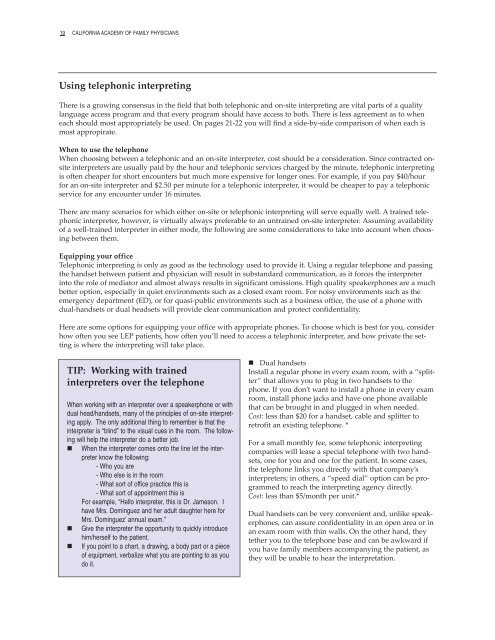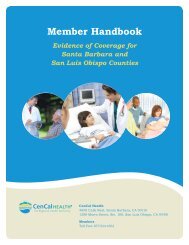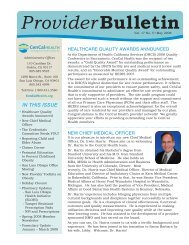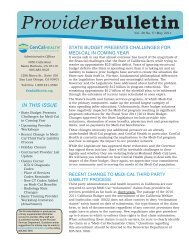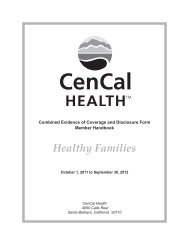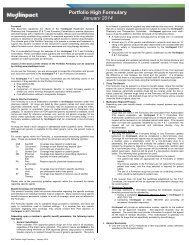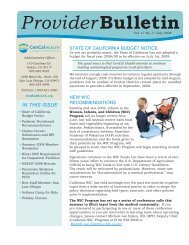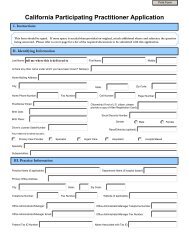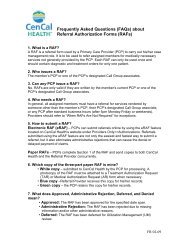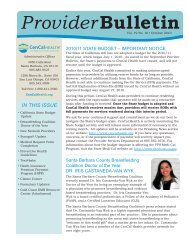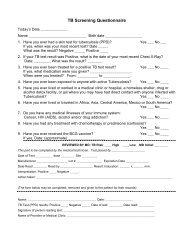Addressing Language Access Issues in Your Practice: A Toolkit for ...
Addressing Language Access Issues in Your Practice: A Toolkit for ...
Addressing Language Access Issues in Your Practice: A Toolkit for ...
Create successful ePaper yourself
Turn your PDF publications into a flip-book with our unique Google optimized e-Paper software.
19 CALIFORNIA ACADEMY OF FAMILY PHYSICIANS<br />
Us<strong>in</strong>g telephonic <strong>in</strong>terpret<strong>in</strong>g<br />
There is a grow<strong>in</strong>g consensus <strong>in</strong> the field that both telephonic and on-site <strong>in</strong>terpret<strong>in</strong>g are vital parts of a quality<br />
language access program and that every program should have access to both. There is less agreement as to when<br />
each should most appropriately be used. On pages 21-22 you will f<strong>in</strong>d a side-by-side comparison of when each is<br />
most appropirate.<br />
When to use the telephone<br />
When choos<strong>in</strong>g between a telephonic and an on-site <strong>in</strong>terpreter, cost should be a consideration. S<strong>in</strong>ce contracted onsite<br />
<strong>in</strong>terpreters are usually paid by the hour and telephonic services charged by the m<strong>in</strong>ute, telephonic <strong>in</strong>terpret<strong>in</strong>g<br />
is often cheaper <strong>for</strong> short encounters but much more expensive <strong>for</strong> longer ones. For example, if you pay $40/hour<br />
<strong>for</strong> an on-site <strong>in</strong>terpreter and $2.50 per m<strong>in</strong>ute <strong>for</strong> a telephonic <strong>in</strong>terpreter, it would be cheaper to pay a telephonic<br />
service <strong>for</strong> any encounter under 16 m<strong>in</strong>utes.<br />
There are many scenarios <strong>for</strong> which either on-site or telephonic <strong>in</strong>terpret<strong>in</strong>g will serve equally well. A tra<strong>in</strong>ed telephonic<br />
<strong>in</strong>terpreter, however, is virtually always preferable to an untra<strong>in</strong>ed on-site <strong>in</strong>terpreter. Assum<strong>in</strong>g availability<br />
of a well-tra<strong>in</strong>ed <strong>in</strong>terpreter <strong>in</strong> either mode, the follow<strong>in</strong>g are some considerations to take <strong>in</strong>to account when choos<strong>in</strong>g<br />
between them.<br />
Equipp<strong>in</strong>g your office<br />
Telephonic <strong>in</strong>terpret<strong>in</strong>g is only as good as the technology used to provide it. Us<strong>in</strong>g a regular telephone and pass<strong>in</strong>g<br />
the handset between patient and physician will result <strong>in</strong> substandard communication, as it <strong>for</strong>ces the <strong>in</strong>terpreter<br />
<strong>in</strong>to the role of mediator and almost always results <strong>in</strong> significant omissions. High quality speakerphones are a much<br />
better option, especially <strong>in</strong> quiet environments such as a closed exam room. For noisy environments such as the<br />
emergency department (ED), or <strong>for</strong> quasi-public environments such as a bus<strong>in</strong>ess office, the use of a phone with<br />
dual-handsets or dual headsets will provide clear communication and protect confidentiality.<br />
Here are some options <strong>for</strong> equipp<strong>in</strong>g your office with appropriate phones. To choose which is best <strong>for</strong> you, consider<br />
how often you see LEP patients, how often you’ll need to access a telephonic <strong>in</strong>terpreter, and how private the sett<strong>in</strong>g<br />
is where the <strong>in</strong>terpret<strong>in</strong>g will take place.<br />
TIP: Work<strong>in</strong>g with tra<strong>in</strong>ed<br />
<strong>in</strong>terpreters over the telephone<br />
When work<strong>in</strong>g with an <strong>in</strong>terpreter over a speakerphone or with<br />
dual head/handsets, many of the pr<strong>in</strong>ciples of on-site <strong>in</strong>terpret<strong>in</strong>g<br />
apply. The only additional th<strong>in</strong>g to remember is that the<br />
<strong>in</strong>terpreter is “bl<strong>in</strong>d” to the visual cues <strong>in</strong> the room. The follow<strong>in</strong>g<br />
will help the <strong>in</strong>terpreter do a better job.<br />
• When the <strong>in</strong>terpreter comes onto the l<strong>in</strong>e let the <strong>in</strong>terpreter<br />
know the follow<strong>in</strong>g:<br />
- Who you are<br />
- Who else is <strong>in</strong> the room<br />
- What sort of office practice this is<br />
- What sort of appo<strong>in</strong>tment this is<br />
For example, “Hello <strong>in</strong>terpreter, this is Dr. Jameson. I<br />
have Mrs. Dom<strong>in</strong>guez and her adult daughter here <strong>for</strong><br />
Mrs. Dom<strong>in</strong>guez’ annual exam.”<br />
• Give the <strong>in</strong>terpreter the opportunity to quickly <strong>in</strong>troduce<br />
him/herself to the patient.<br />
• If you po<strong>in</strong>t to a chart, a draw<strong>in</strong>g, a body part or a piece<br />
of equipment, verbalize what you are po<strong>in</strong>t<strong>in</strong>g to as you<br />
do it.<br />
• Dual handsets<br />
Install a regular phone <strong>in</strong> every exam room, with a “splitter”<br />
that allows you to plug <strong>in</strong> two handsets to the<br />
phone. If you don’t want to <strong>in</strong>stall a phone <strong>in</strong> every exam<br />
room, <strong>in</strong>stall phone jacks and have one phone available<br />
that can be brought <strong>in</strong> and plugged <strong>in</strong> when needed.<br />
Cost: less than $20 <strong>for</strong> a handset, cable and splitter to<br />
retrofit an exist<strong>in</strong>g telephone. *<br />
For a small monthly fee, some telephonic <strong>in</strong>terpret<strong>in</strong>g<br />
companies will lease a special telephone with two handsets,<br />
one <strong>for</strong> you and one <strong>for</strong> the patient. In some cases,<br />
the telephone l<strong>in</strong>ks you directly with that company’s<br />
<strong>in</strong>terpreters; <strong>in</strong> others, a “speed dial” option can be programmed<br />
to reach the <strong>in</strong>terpret<strong>in</strong>g agency directly.<br />
Cost: less than $5/month per unit.*<br />
Dual handsets can be very convenient and, unlike speakerphones,<br />
can assure confidentiality <strong>in</strong> an open area or <strong>in</strong><br />
an exam room with th<strong>in</strong> walls. On the other hand, they<br />
tether you to the telephone base and can be awkward if<br />
you have family members accompany<strong>in</strong>g the patient, as<br />
they will be unable to hear the <strong>in</strong>terpretation.


